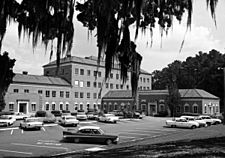- This page was last modified on 17 October 2025, at 10:18. Suggest an edit.
Florida A&M Hospital facts for kids
| Florida A&M Hospital | |
|---|---|

Florida A&M Hospital, circa 1960s
|
|
| Geography | |
| Location | Tallahassee, Florida, United States |
| Coordinates | 30°25′34″N 84°16′59″W / 30.426124°N 84.282935°W |
| Organization | |
| Hospital type | General |
| Affiliated university | Florida Agricultural and Mechanical University |
| Services | |
| Beds | 105 |
| History | |
| Closed | 1971 |
The Florida A&M Hospital (open from 1911 to 1971) was a very important place in Florida's history. It was the first hospital in Florida to offer medical care to African Americans. During a time called segregation, many hospitals only treated white patients. This meant African Americans often could not get the medical help they needed.
The Florida A&M Hospital was a safe place for African Americans to receive care. It was also the only hospital of its kind for about 150 miles around Tallahassee. In 1940, very few counties in Florida had hospitals for Black people.
Founding the Hospital
The hospital first opened in 1911. It was called a "sanitarium" back then. It had 19 beds and was built to help Florida A&M University (FAMU) start a nursing program. This program would train nurses.
The first building was made of wood. It was replaced in 1950 by a larger, brick building with 105 beds. Part of the money for this new hospital came from efforts to keep hospitals separate. This was part of the "separate but equal" idea, which meant having separate facilities for different races.
The hospital was officially named the FAMC Hospital, Health Center, and Nursing School in 1946. It was formally dedicated as a hospital in 1951. Like many hospitals for African Americans during this time, it often did not have enough money. Tallahassee collected taxes to support the white-only hospital. However, it refused to give any of these funds to the FAMU hospital.
Its Important Role
The Florida A&M Hospital played a huge role in healthcare and education. It was supervised by Jennie Virginia Hilyer, a registered nurse. She was a graduate of Freedmen's Hospital in Washington, D.C. This hospital is now called Howard University Hospital.
In 1926, Dr. Leonard H.B. Foote became the hospital administrator. He was a doctor who graduated from Howard University Medical School. Dr. Foote started FAMC's School of Nursing in 1936. This was the first nursing program in Florida that offered a Bachelor's degree.
Dr. Foote led a 10-year effort to build the new, modern brick hospital. This new building opened in 1950. The hospital became a major medical center. It provided important training for students. It also offered chances for medical research.
Closure of the Hospital
The hospital closed in 1971. This happened because of the Civil Rights Act of 1964. This law made racial segregation illegal. The federal government said it would stop giving Medicare money to hospitals that continued to separate patients by race. This affected both the FAMU hospital and Tallahassee Memorial Hospital.
Tallahassee Memorial Hospital then started to admit Black patients. Federal and state money that used to support the FAMU Hospital was moved to Tallahassee Memorial. When state funding ended in 1967, the FAMU hospital's name was changed to Tallahassee A&M Hospital. It was then leased to the city and county.
On December 24, 1971, the Hospital Board announced it was closing the hospital. They said they were losing too much money. FAMU President Dr. B. L. Perry, Jr., explained some reasons for the closure. He said white doctors were unwilling to send patients to the hospital. There were also not enough Black doctors in the area. Nurses' salaries were also too low, which made it hard to find new staff.
Sadly, when segregation ended in the U.S., it was often the Black facilities that closed. This meant many employees lost their jobs.
A Lasting Legacy
Even though the hospital closed, its history is remembered. In 2013, two historical markers were put up. One is in front of the old hospital building. The other is at an entrance to the FAMU campus.
The marker text tells the hospital's story:
THE FLORIDA A&M UNIVERSITY HOSPITAL (1911-1971) The first healthcare facility built in Florida for African-Americans was the Florida A&M College (FAMC) Hospital. It was known as the Florida A&M University (FAMU) Hospital after 1953. The school's first two-story, 19-bed wooden sanitarium was built in 1911. It provided medical care to patients of all races in Leon and nearby counties.
Jennie Virginia Hilyer, RN, supervised it. She was a graduate of Freedmen's Hospital in Washington, D.C. In 1926, Leonard H.B. Foote, MD, became hospital administrator. He started FAMC's School of Nursing in 1936. This was the first baccalaureate nursing program in Florida. He led a 10-year effort to build a new, modern brick hospital, which opened in 1950.
As a major medical center, the hospital trained students and offered research chances. After federal and state support was removed, the hospital closed on December 11, 1971. Today, the hospital's legacy lives on. It continues through Florida A&M University's School of Nursing, College of Pharmacy, and School of Allied Health Sciences.
The building that was once the hospital is now called the Foote-Hilyer Administration Building. It still has the university's student health center inside.
